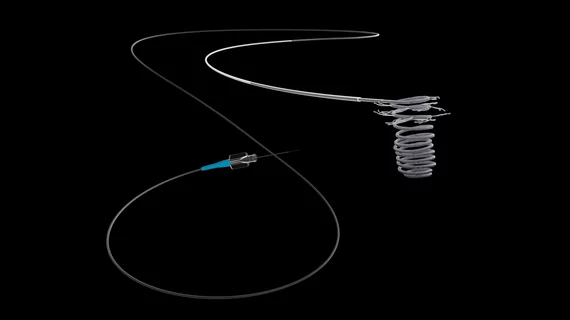Regulatory roundup: FDA clears new solutions from Boston Scientific, CathVision, Franklin Mountain Medical
It has been a busy few weeks for the U.S. Food and Drug Administration (FDA). The agency approved mavacamten (Camzyos) for obstructive hypertrophic cardiomyopathy, for example, and announced a Class I recall of the delivery catheter from Medtronic’s Harmony transcatheter pulmonary valve system.
In addition, multiple solutions also received FDA clearance in recent weeks, and some of them are especially noteworthy for cardiologists and other healthcare professionals. Let’s review:
1. Boston Scientific’s Embold Fibered Detachable Coil
Boston Scientific gained FDA clearance for its Embold Fibered Detachable Coil, a new device developed to assist interventional clinicians with embolization procedures. The Embold Fibered Coil obstructs or reduces blood flow in the patient’s peripheral vasculature.
The first patient was treated with this new device in April, according to a statement from Boston Scientific. The interventional radiologist who performed that procedure, Theresa M. Caridi, MD, spoke about her experience with the device.
“When performing an embolization procedure, it is essential to have a device that is easy to use from start to finish,” Caridi, director of the division of vascular and interventional radiology at the University of Alabama at Birmingham, said in the statement. “The multi-catheter compatibility of the Embold Fibered Coil provides physicians the flexibility of catheter choice and helps reduce the number of potential device exchanges, which may improve procedure efficiency and enable better patient outcomes.”
A full U.S. launch of the Embold Fibered Coil is expected soon.
2. CathVision’s ECGenius EP Recording System
CathVision, a Denmark-based healthcare technology company, has received FDA clearance for its ECGenius EP Recording System. The new solution was designed to improve care in the electrophysiology (EP) lab by delivering high-fidelity electrocardiogram (ECG) recordings that make it easier to diagnose and treat arrhythmias such as atrial fibrillation (AFib).
According to a prepared statement from CathVision, ECGenius represents a “necessary evolution” in ECG signal acquisition.
“Our mission is to put electrophysiologists in the best position to improve clinical outcomes, and the basis for electrophysiology is the quality of the cardiac electrograms,” Mads Matthiesen, CathVision’s CEO, said in the statement. “The ECGenius System offers clean, unfiltered signals, and by replacing existing conventional EP recording systems, we give physicians a new way of looking at electrograms without adding more equipment to their EP labs.”
“ECGenius is setting a new standard for EP recording technology by providing clean electrical activation signals even in the most complex arrhythmias,” added Peter Spector, MD, a professor of medicine and engineering and director of cardiac electrophysiology at the University of Vermont. “This makes it possible to observe even minor, but significant, signal modifications.”
The ECGenius system is not yet available for sale in the European Union.
3. Franklin Mountain Medical’s UltraNav Transseptal Catheter System
Franklin Mountain Medical, a subsidiary of Franklin Mountain Capital, has received FDA clearance for its UltraNav Transseptal Catheter, a new solution designed to improve visualization during transseptal procedures.
The lead inventor of the UltraNav system was Nabil Dib, MD, an interventional cardiologist and professor of medicine with the University of Arizona. He aimed to develop a new treatment option that helps cardiologists successfully deliver cardiovascular catheters, including intracardiac echocardiography (ICE) catheters and guidewires, into the patient’s heart chambers. The dual-lumen catheter’s design “provides precise and complete visualization of catheter orientation, needle length and needle tip location relative to the cardiac structure,” according to a statement from Franklin Mountain Medical.
“The complete, continuous visualization and delivery of catheters will result in more precise punctures and easier catheter navigation, which should improve the safety and performance of septal puncture and structural procedures,” Dib said.
Related Vascular and Endovascular Content:
How to improve shared decision-making among vascular surgeons and their patients
4 support catheters receive FDA clearance for coronary use
Virtual reality specialists launch new training solutions for endovascular surgery

